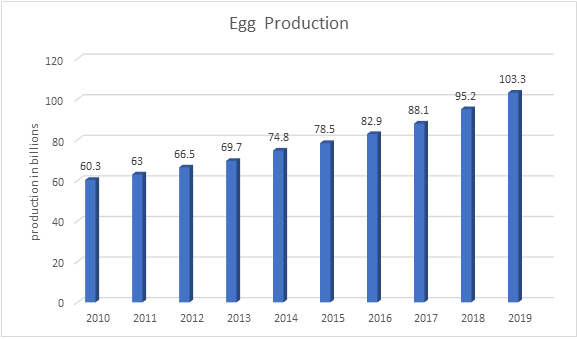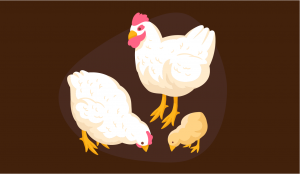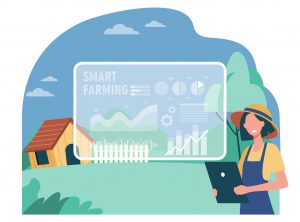
EGG rates in India
Poultry Chicken and eggs play a prominent role in the Indian economy. Poultry farming is where we raise domestic birds for their meat and eggs. In poultry, chickens are farmed in exceptional numbers. Layers are the birds that are bred for the purpose of their eggs. Typically, there are two types of poultry farming in India, namely, backyard farming and commercial farming. The commercial poultry industry is one of the fastest developing fields in India. “The egg production has an increase of 8 to 10 percent per annum all over India. ”
Escalation of Egg growth in India:
In the year 2017, the Indian egg market price reached INR 1,494 billion, and it is estimated to reach INR 3,775 billion by the year 2023, with a CAGR (compound annual growth rate) go 16.5% between the years 2018-2023. As the demand for poultry eggs is increasing there are companies forming their own brand to grab the growing opportunity. Retailers started to keep the stock of eggs so that they could sell the eggs at a less price than that of the branded companies. As the global consumption rate is increasing there is a gradual growth in the poultry economy. It is estimated that by 2030 there will be enough production to satisfy the consumers.
How poultry app helps in your business:
We at Poultry app help farmers to grow in their business, and our motto is to make their job easy by using the poultry application. Poultry app helps farmers in feed conversion ratio, can check the nearby feeder and supplier and maintain inventories. A wholesaler can find nearby farmers, retail shops , and manage inventories without bookkeeping. They can also track all their farm vehicles within the application.
You can add temporary farms, temporary farm vehicles, temporary retailers in this application. With poultry application, your work becomes easier. The farmer needs to check the news regularly for updates on prices, with the poultry application it is easy for the farmer to receive notifications regularly on market rates and our application is handy to the whole poultry community with our poultry application.
Why is prodcution cost higher than market price(NECC)
Where the table eggs are made of low-cost production? There was a lot of price variation in selling the eggs from year to year. In the year, 2011 the price of an egg is 3.13rs per piece. Now the egg prices have increased due to the increase in the consumption of the eggs and a short supply of eggs. In 2020, the retail price of the egg is 5.65rs.
As the demand increased and the supply is low the prices have increased gradually. In 2018 the production cost was 3.83rs and the NECC price was 3.63rs. In 2019 NECC price stood at 3.66rs but the production cost was 4.09rs.
As a result, farmers have sold their layer chicken for meat as the meat prices are high. Due to the short supply of eggs, demand has increased for the eggs. Layer chicken can produce up to 1kg of eggs by consuming 2.25kg of food during the laying period.
Commercial layers can produce up to 300 eggs during a year. As laying birds plays a vital role in layer farming, Poultry farmers are trying to get high-quality chicks with better equipment, vaccines, and medicines and farmers make sure that they are healthy and not infected.
How egg consumption increased in India:
Globally, eggs are mostly consumed in japan standing in the 1st position with 52.46%, Paraguay follows next with 51.59%. States that consume the highest ratio of eggs in India are Andhra Pradesh, which stands in the 1st place of consumption with 346 per capita, Tamil Nadu takes the 2nd position with 246 per capita, 3rd stands Haryana with 209 per capita. And the size of the industry is increasing according to the per capita consumption in rural and urban areas.
Per capita consumption of egg is 7.7 percent in the rural areas and in the urban areas the consumption is 17.8 percent per annum. The government makes sure that kids get an egg every day. Asia is the largest producer and consumer of eggs which is 2 out of the top 3 worldwide consumers and 5 out of top 10 national producers and it has a huge market growth over the decades.
China and Japan stand in the top 3 of the egg consumers lists. They will be one of the best influencers on the market. China will be undefeated as it is producing 50% of the production, and the consumption rate is being accelerated because of the Chinese.
Egg production:
India produces about 1.67 million metric tons of eggs every year. India stands in the 3rd place with 6% production of eggs, as China stands in the first place of the egg production with 42% of global production, USA stands in the 2nd place with 7% of egg production. The top 3 states that produce a large number of eggs are Tamil Nadu with 54.76%, Maharashtra with 32.47%, Kerala with 12.58%. In 2012, the production rate of eggs in India is 3.16 million metric tons.
As the production increased the demand for eggs also increased in the market. By comparing it with 2012, there was a drastic increase in 2013 where the production increased by 29 million metric tons. By the year 2018, the production of eggs has increased to 95 billion metric tons.

As we can see in the above graph, in the year 2010 the layer production was 60.3 billion and by 2019 it was 103.3 billion. The poultry industry is thinking about how to feed 9 billion people by the year 2050 globally and it is a challenge to the industry where they have to achieve the goal without damaging any environment, where only 40% have presently inhabited the planet. The global demand is increasing from an urban population which results in the increase of purchasing capacity of eggs.
Egg export:
India started to export eggs from the year 2006. The poultry industry also started to see growth since then. According to data during 2017 India stood in 17th place in the egg export as one of the largest exporters of eggs in the world. India exported with 72.02% during 2017. In USD India has exported about 33.3 million eggs. By 2019, India exported 22.2 million over the year.
The percentage of export decreased comparing to the previous years, but still, India stood in the 13th position. As the Netherlands stands in 1st place by exporting 470.7 million eggs Poland stands 2nd with about 247.8 million eggs over the year 2019. Table eggs demand is increasing day by day with a short supply.
India is exporting large units of eggs to other countries apart from domestic consumption.
Egg Storing:
Eggs are washed before going outside of the farm. So that the egg will not be spoiled quickly, the USA has initiated the process of washing eggs with sprinkling washers and sanitizing the eggs. Australia and Japan have adopted the process of sanitizing the eggs. The white shell eggs are kept at 7 degrees Celsius. So that the eggs are being stored in the cold containers the farmers have the possibility of facing huge profits.
Feed and formation of egg:
The layer embryo forms for 21days and then the chicken starts to lay the eggs. According to the heat conditions, they lay either one egg per day or more. And the farmers make sure that the chick gets enough protein while growing. Once the layer start laying eggs then you can start feeding them layer feed with the high protein of 16%- 20% which is a mixture of vitamins, minerals.
Calcium should be about 3 ½ percent in the layer feed. The layers lay eggs when the temperature is 11 and 26 degrees Celsius or about 52 to 79 degrees. To increase the size of the egg linoleic, light and ventilation also play a key role and they can also use supplemental oils such as soya bean oil or flaxseed.
Closure:
In the above content, we discussed egg rates. As the poultry industry is evolving there is an assumption that the price of the eggs will diminish according to the period so that they are affordable to the common man. As new techniques are developing in the poultry industry the farmers are increasing the production rate by comparing the consumption rate. The poultry industry also started on digital platforms where farmers can learn new things and find their business. Poultry app helps you in a digitalized way of developing your business. We can see a bright future for the poultry industry in India.

Latest post

Mortality and bird disposal

Poultry and the climatic conditions

Poultry brooding management

Poultry flea’s infestation and management

Poultry house design
